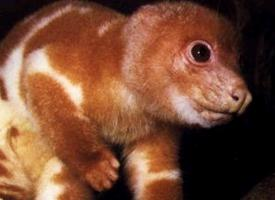
Súlyok és méretek
| Hossz | 44 cm |
|---|---|
| Súly | 2,5-tól 3-ig kg |
| Farokhossz | 33 cm |
Állatleírás
The Ground Cuscus, scientifically known as Phalanger gymnotis, is a fascinating marsupial native to the tropical forests of New Guinea and nearby islands. This intriguing animal belongs to the family Phalangeridae, which includes various species of possums and cuscuses. The Ground Cuscus exhibits a unique set of characteristics and behaviors that make it a subject of interest among wildlife enthusiasts and researchers alike.Physical Appearance:
The Ground Cuscus has a robust and somewhat stocky build, with a body length ranging from 35 to 65 centimeters (14 to 26 inches) and a tail that can be just as long, if not longer, than its body. One of its most striking features is its dense fur, which varies in color from greyish to brown, providing excellent camouflage in its forested habitat. The underbelly is usually lighter, often a creamy white. Its rounded head houses a pair of small, but keen, eyes and a short snout, which gives it a somewhat teddy bear-like appearance. The ears are small and often partially hidden in its thick fur.
The tail of the Ground Cuscus is prehensile, meaning it can grasp and hold objects. This tail is partially naked, which enhances its grip on branches, making it an essential tool for climbing and navigating the dense canopy. Additionally, its strong, clawed feet aid in its arboreal lifestyle, allowing it to cling to tree trunks and branches with ease.
Habitat and Distribution:
Predominantly found in the lush rainforests of New Guinea, the Ground Cuscus prefers dense forest areas where it can easily hide and forage for food. It is an arboreal creature, spending most of its life in the trees, although it is named the "Ground" Cuscus because it is more likely than its relatives to descend to the ground in search of food or shelter.
Diet and Behavior:
The Ground Cuscus is primarily nocturnal, venturing out at night to feed. Its diet consists mainly of leaves, fruits, flowers, and occasionally small insects and eggs. This dietary flexibility allows it to thrive in various environments. During the day, it retreats to the safety of tree hollows or dense foliage to sleep and avoid predators.
Reproduction and Lifecycle:
Like other marsupials, the Ground Cuscus has a unique reproductive process. After a brief gestation period, the underdeveloped young are born and immediately crawl into the mother's pouch. There, they continue to develop and grow, feeding on milk from the mother's teats. Once they are sufficiently mature, they begin to venture outside the pouch but remain close to their mother for protection and nourishment until they are independent.
Conservation Status:
The conservation status of the Ground Cuscus has not been extensively studied, but habitat destruction and hunting pose significant threats to its population. Deforestation for agriculture and human settlement reduces its natural habitat, while hunting for food and fur has also impacted some local populations.
In summary, the Ground Cuscus is a remarkable marsupial with a unique set of adaptations that allow it to thrive in the dense forests of New Guinea. Its nocturnal habits, diverse diet, and arboreal lifestyle make it a fascinating subject for further study, highlighting the importance of conserving its natural habitat to ensure its survival.
Hasonló állatok
Új állatfotók
Top 10 állat
- Dolphin gull (Leucophaeus scoresbii)
- Japanese macaque (Macaca fuscata)
- Stone loach (Barbatula barbatula)
- Russian tortoise (Testudo horsfieldii)
- Galápagos tortoise (Geochelone nigra complex)
- Greek tortoise (Testudo graeca)
- Diana monkey (Cercopithecus diana)
- Common flying dragon (Draco volans)
- Moustached guenon (Cercopithecus cephus)
- Galápagos penguin (Spheniscus mendiculus)

